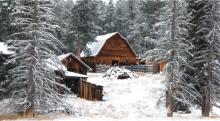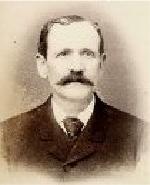Alfred D Sears and the 20th Century Dairy Business in Deadwood SD by Jack Sears DHS1958
DickD Comment: Jack Sears DHS1958 is a great supporter of my dhsclassmates website publication since it started in 2007. He always contributes quality posts that show his research and attention to detail. We correspond frequently and I value his council and suggestions. He shares pride of the Deadwood School/High School's quality education system and the life ethic/values they instilled in each student.
Jack shares interest in the rich history of Deadwood. I am sure you will enjoy Jack's family history in Deadwood.
~~~~~~~~~~~~~~~~~~~~~~~~~~~~~~
 |
| Jack Sears DHS1958 |
Dick, when you invited me to write about the creamery my grandfather operated in Deadwood in the early 1900s, I hesitated because I know so little about it. I remember that, after my grandmother died and we moved into her house on Terrace Street in 1946, there were a few boxes full of old receipts and bills from the creamery, but that was it. No pictures or anything of much interest.
Gradually, I became more aware that my grandfather Alfred D. Sears had once run something called a creamery -- I remember my dad showing my brother Rich and me where it had been, at 771 Upper Main (near the present "armory building"). I didn't know what a "creamery" was, or what made it different from a dairy. Later I learned that, back in the day, "dairy" butter was sold by the farm wives who made it by hand; in the 1860s, butter factories, or "creameries," began producing butter in mechanized factories in the East.
The Deadwood Public Library has microfilm of old editions of the Deadwood Daily Pioneer, some of which carried ads for my grandfather's Elgin System Creamery in Deadwood. The creamery was affiliated with The Elgin Butter Company of Elgin, Illinois, which had developed a factory system of butter making in the 1870s and gradually expanded westward.
 |
| The Deadwood Daily Pioneer Sunday February 1st 1903 |
Upon arrival in Deadwood Alfred opened the 771 Main Street creamery. It got off to a good start and the family soon settled in at 23 Monroe Street. Little Rich Sears (my uncle) entered the first grade class of Olive "Dottie" Smith.
Alfred became an avid trout fisherman, and the family soon grew to love the Hills through frequent outings to places such as Spearfish Canyon and Sand Creek.
In 1904, The Black Hills Illustrated noted:
This creamery, the largest in the Black Hills, which is owned by A. D. Sears, is worthy of special mention. It has a capacity of 2,000 pounds of butter per day. It is now making from 1,000 to 1,200 pounds per day, and is increasing fast. Five people are employed in the work and the cream is brought mainly from nine gathering stations in Nebraska, from 200 to 400 miles distant, and shipped in by express. . . . The butter is sold in every town in the Black Hills and shipment has been made as far east as New York City.
Mr. Sears also manufactures ice cream, with a rapidly increasing trade, and does a large poultry and egg business, the poultry being kept alive and utilized as trade demands. The principal jobbing business of the Hills in eggs is done by this creamery, which also conducts a wholesale trade in cream.
The creamery grew, too, and by 1908 employed a dozen workers -- but that year the Alfred Sears family suffered a major blow when their little girl Katharine died at birth. The next year they sold the creamery and moved back to Fremont, taking the little girl's body with them for reburial. As close as they had become to Deadwood and the Hills, it was time to go back to Jo's home and the support of her extended family.
The creamery was then bought by the Beatrice Creamery Company, which later became known as Meadow Gold and was eventually taken over by Borden's.
The creamery was then bought by the Beatrice Creamery Company, which later became known as Meadow Gold and was eventually taken over by Borden's.
Once back in Fremont, Alfred left the dairy business behind and started a new construction company. For the next several years he built railroads, and the roads and bridges increasingly needed for the newfangled automobile.
 |
| Alfred D. Sears Construction, Freemont NB |
By 1919, after finishing a construction project for the Northwestern in Chadron, the Sears family decided it was time to return to the Hills and to Deadwood, and Alfred took over the creamery for a second time. But his health soon began to fail and he passed away; I don't know what became of the creamery after that. My memories are from a later time, of going out on cold mornings to find cardboard caps raised out of their bottles on columns of frozen milk, a time when dairies such as Kelly's and Gaughn's delivered right to the door.
My grandmother chose to stay on in Deadwood in the home on Terrace Street until her own death in 1944, enjoying dinners and bridge parties with old friends like Edna Ford (an 1893 DHS graduate), Maude Dennee Ogden (who came with her family to Deadwood in 1876), Grace McGahey (wife of Adams Museum curator D. M. McGahey), Mabel DeMouth Hartley and, everybody's favorite first grade teacher, Olive Rae ("Dottie") Smith.
Early 20th Century was the heyday of railroads, and travelers to Deadwood had a choice: the Fremont, Elkhorn and Missouri Valley Line, which reached Deadwood in December 1890, or its competitor the Grand Island and Wyoming Central, that finished its own line to Deadwood just one month later.
The families of many of our schoolmates would have arrived on the same railroads -- maybe in the same cars -- later known as the Chicago and North Western, and the Burlington. No one then would have anticipated that the age of railroads was ending, and that our generation would be the last to ride the old steam powered passenger trains, like the Burlington that my family and I took when we moved from Fremont to Deadwood in 1946.
The families of many of our schoolmates would have arrived on the same railroads -- maybe in the same cars -- later known as the Chicago and North Western, and the Burlington. No one then would have anticipated that the age of railroads was ending, and that our generation would be the last to ride the old steam powered passenger trains, like the Burlington that my family and I took when we moved from Fremont to Deadwood in 1946.





